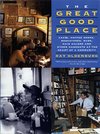
Ray Oldenburg & Karen Christensen: third places, true citizen spaces

The term, which was coined by the sociologist Ray Oldenburg in the 1980s, essentially refers to a physical location other than work or home where there’s little to no financial barrier to entry and where conversation is the primary activity. The historical examples that Oldenburg cites in his book The Great Good Place include French cafés, German... See more
Allie Conti • We Really Should Hang Out More Often
Third place
en.wikipedia.org
The Great Good Place: Cafes, Coffee Shops, Bookstores, Bars, Hair Salons, and Other Hangouts at the Heart of a Community
amazon.com